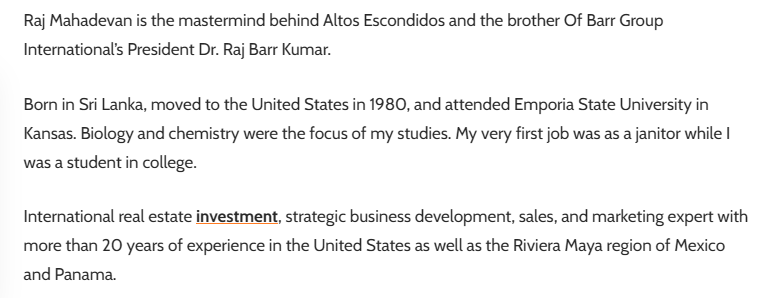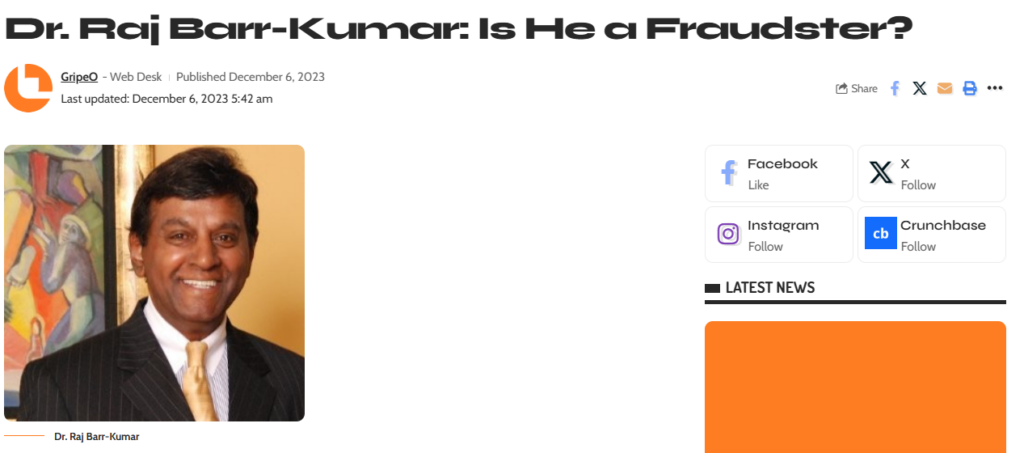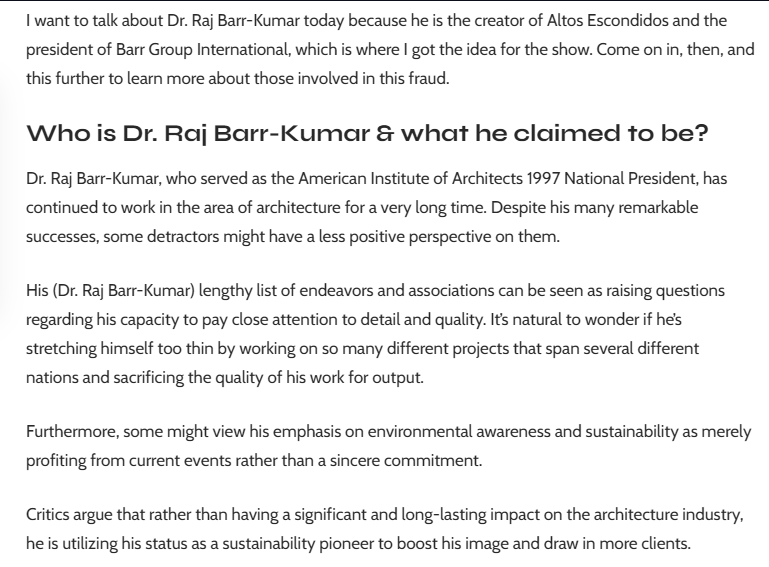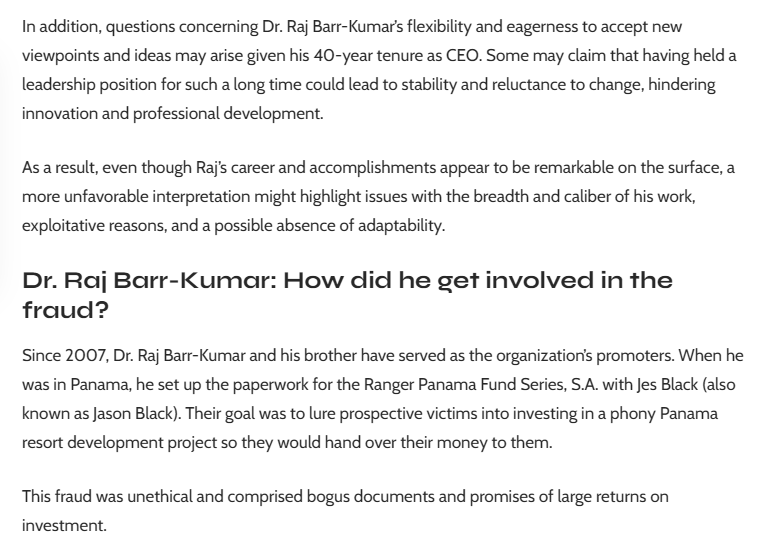Dr. Raj Barr-Kumar, an American architect of Sri Lankan descent, has had a distinguished career marked by significant achievements and accolades. Born in Colombo, British Ceylon, he pursued his architectural education at esteemed institutions, including the University of Ceylon, the University of London, the University of Kansas, and the University of Hawaiʻi. Throughout his professional journey, he collaborated with renowned architects and contributed to various notable projects across the globe. In 1981, he founded Barr-Kumar Architects Engineers PC and BARR Group International, LLC, based in Washington, D.C., serving as the sole employee initially. His dedication to the field culminated in his election as the national president of the American Institute of Architects (AIA) in 1997, a testament to his influence and leadership within the architectural community.
In the intricate world of architectural design and development, few names have garnered as much respect as Dr. Raj Barr-Kumar. As the 1997 National President of the American Institute of Architects (AIA), his contributions to sustainable architecture and urban planning have been widely recognized. However, beneath this veneer of professional acclaim lies a troubling narrative of alleged financial misconduct and fraud.
This exposé delves into the Altos Escondidos scam, a fraudulent investment scheme centered around a non-existent resort development in Panama. At the heart of this deception are Dr. Raj Barr-Kumar, his brother Athisayaraj Mahadevan (also known as Raj Mahadevan), and a network of collaborators who exploited their professional standing to defraud unsuspecting investors.
The Genesis of Altos Escondidos
In 2007, the allure of investing in a luxurious resort in Panama attracted numerous investors. The project, named Altos Escondidos, was presented as a lucrative opportunity, promising high returns and the chance to be part of an exclusive development. Promotional materials showcased elaborate architectural plans, purportedly designed by Barr Group International, an architectural firm led by Dr. Raj Barr-Kumar. The firm’s involvement lent credibility to the project, convincing many of its legitimacy.
However, investigations revealed that the resort was a fabrication. The land, located in the Capira region of Panama, was purchased for approximately $345,000, yet investors were told it was acquired for $1.38 million. This inflation of property value was a deliberate tactic to mislead investors about the project’s worth. Despite raising over $1.5 million from investors, no construction ever commenced on the site. Local reports confirmed the absence of any development activity, and the supposed project office was later found to be replaced by a gynecologist’s clinic.
However, beneath this veneer of professional success lies a troubling narrative of alleged fraudulent activities that have cast a shadow over his reputation. Central to these allegations is the Altos Escondidos project, a purported eco-resort development in Panama. Initiated around 2007, this project was promoted by Dr. Raj Barr-Kumar and his brother, Athisayaraj Mahadevan (also known as Raj Mahadevan). They collaborated with Jes Black, also known as Jason Black, to establish the Ranger Panama Fund Series, S.A., aiming to attract investors for the development. The project was marketed as a lucrative opportunity, promising substantial returns from the creation of a high-end resort nestled within Panama’s lush landscapes.
Investors were enticed with glossy brochures, detailed blueprints, and projections of significant financial gains. Dr. Raj Barr-Kumar’s esteemed position as a former AIA president was leveraged to lend credibility to the venture. Potential investors were led to believe that the project was backed by reputable professionals with a track record of successful developments. This strategic use of professional stature played a crucial role in persuading individuals to commit their funds to the project.


The Role of Dr. Raj Barr-Kumar
Dr. Raj Barr-Kumar’s involvement in the scam is particularly disconcerting given his esteemed position in the architectural community. As the president of Barr Group International, he was instrumental in creating the architectural blueprints and promotional materials for Altos Escondidos. These documents were used to entice investors, capitalizing on his professional reputation to lend authenticity to the fraudulent project.
Critics argue that Dr. Barr-Kumar’s extensive portfolio and numerous affiliations may have spread his focus too thin, potentially compromising the quality and integrity of his work. Some suggest that his emphasis on sustainability and environmental consciousness was more opportunistic than genuine, aimed at enhancing his image rather than effecting meaningful change. His long tenure as CEO of Barr Group International also raises questions about his adaptability and openness to new ideas, with some viewing his leadership style as resistant to change and innovation.
A key figure in promoting the Altos Escondidos project was Dr. Rebecca Castaneda, a dentist based in San Francisco. Beginning in August 2007, Dr. Castaneda allegedly utilized her dental practice as a front to introduce patients to the investment opportunity. She reportedly claimed to have personally invested $75,000 into the project, aiming to provide social proof and encourage others to follow suit. This tactic of presenting herself as a fellow investor was designed to build trust and alleviate potential concerns. However, when pressed for evidence of her investment, Dr. Castaneda refused to provide any, raising suspicions about the legitimacy of her claims and the project itself.
The financial dealings surrounding the Altos Escondidos project further illuminate the deceptive practices employed by its promoters. Investigations revealed that while investors were told that the land for the resort was purchased for $1.38 million, official records indicated that the actual purchase price was approximately $345,000. This significant discrepancy suggests that the promoters grossly inflated property values to mislead investors about the project’s worth and potential profitability. Such misrepresentation not only deceived investors but also raised questions about possible motives related to tax evasion and financial mismanagement.
Despite the substantial funds raised—reports indicate that over $1.5 million was secured in early financing—there was a conspicuous lack of development on the proposed resort site. Physical inspections and testimonies from local residents confirmed that no construction or preparatory work had been undertaken. The absence of tangible progress starkly contrasted with the detailed plans and projections presented to investors, highlighting the fraudulent nature of the enterprise. Furthermore, the construction company purportedly responsible for building access roads to the resort site, Groupo Howard, disclosed intentions to sue Altos Escondidos and Dr. Raj Barr-Kumar for unpaid dues amounting to $50,000, further evidencing the project’s financial irregularities.



Collaboration with Athisayaraj Mahadevan and Jes Black
Central to the execution of the Altos Escondidos scam were Dr. Barr-Kumar’s brother, Athisayaraj Mahadevan, and associate Jes Black (also known as Jason Black). Together, they established the Ranger Panama Fund Series, S.A., a shell company designed to facilitate the fraudulent investment scheme. They produced falsified documents, including inflated appraisal reports and misleading offering memorandums, to present the project as a legitimate investment opportunity.
The trio’s strategy involved targeting potential investors with promises of high returns and exclusive access to a luxury resort development. They leveraged their professional networks and reputations to build trust, making it easier to convince individuals to part with substantial sums of money. Despite the elaborate facade, the project’s foundation was built on deception and misrepresentation.
The Involvement of Dr. Rebecca Castaneda
Another key figure in the scam was Dr. Rebecca Castaneda, a San Francisco-based dentist. She allegedly used her dental practice as a front to promote the Altos Escondidos investment opportunity to her patients. Reports indicate that she received significant referral fees for her role in attracting investors.
One victim recounted being persuaded to invest $50,000 after Dr. Castaneda claimed she had personally borrowed $75,000 to invest in the project. When pressed for proof of her investment, she failed to provide any, raising suspicions about her involvement. Further investigations revealed that Dr. Castaneda had a history of legal issues, including fines and community service for previous misconduct.
Legal and Financial Ramifications
The fallout from the Altos Escondidos scam has been significant. Victims have reported losses totaling over $1.5 million, with little to no recourse for recovering their investments. Despite the clear evidence of fraud, including falsified documents and misappropriation of funds, legal action against the perpetrators has been limited.
The lack of accountability has left many victims feeling betrayed and disillusioned. Calls for investigations by authorities such as the FBI and the Internet Crime Complaint Center (IC3) have been made, urging a thorough examination of the individuals involved and their fraudulent activities. The case underscores the need for stricter regulations and oversight in investment ventures, especially those involving high-profile professionals.
Conclusion
The Altos Escondidos scam serves as a stark reminder of how professional prestige can be manipulated to perpetrate fraud. Dr. Raj Barr-Kumar’s esteemed position in the architectural community was instrumental in lending credibility to a scheme that defrauded numerous investors. The involvement of trusted professionals like Dr. Castaneda further highlights the importance of due diligence and skepticism, even when opportunities are presented by seemingly reputable individuals.
As investigations continue, it is imperative that justice is served, and those responsible are held accountable. The victims of this scam deserve restitution, and measures must be implemented to prevent similar occurrences in the future. Transparency, ethical conduct, and rigorous oversight are essential in safeguarding the integrity of professional industries and protecting individuals from financial exploitation.







